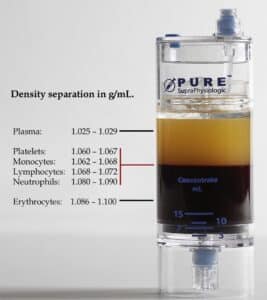There are several different ways that you can concentrate platelets contained in whole blood to create Platelet-Rich-Plasma (PRP). These include filtration, apheresis, selective absorption and centrifugation. Centrifugation is by far the most popular way that physicians create PRP at the point of care. Within the realm of centrifugation there are two methods commonly applied; those are single spin and dual spin. In this article we will explore both methods in depth.
Before we jump into the different concentration methods it is helpful to quickly review the components of whole blood and the concept of enriching the plasma portion with platelets prior to discussing specific techniques. Whole blood is a complex fluid made up of constituent parts with different densities. We can analyze these different densities by using a term called specific gravity where we set the density of water to 1.0 and compare other fluids against it. Anything with a specific gravity below 1.0 is less dense than water and anything greater than 1.0 is denser, thus the higher the number the greater the density.

Here we see an EmCyte PRP tube after 60cc of whole blood has undergone the first centrifugation spin. This provides a good illustration of whole blood components separated by their respective densities. Plasma is the least dense layer with an SG of 1.025-1.029. Platelets are next with an SG of 1.060-1.067. The white blood cell layer is next with an SG of 1.062-1.072. Finally, the erythrocytes or red blood cells have an SG of 1.086-1.100. This scale of component densities is referred to as a gradient. The goal of PRP centrifugation is to stratify these different components into layers, which is called density gradient centrifugation. There are a couple of important points to make here. One is that the densities of the different components are not completely separated from one another, there is overlap. Second, in theory these different densities would perfectly separate into their respective layers, however in the practice of centrifugation these layers do not perfectly separate due to several factors such as boundary tension, viscosity, particle sizes, centrifugal force – either too high or too low, and time of centrifugation. With this foundation in place let’s move on to discuss dual spin and single spin preparations.
Single Spin PRP
We’ll begin this discussion with the pros and cons of single spin PRP. Pros: lower cost, faster processing time, lower whole volume blood draw (generally, not always). Con: lower platelet concentration. You’ll often hear single spin companies advertising phenomenal concentration folds of 10x or greater. This is simply untrue. Let’s discuss why. Single spin means the whole blood is subjected to one cycle of centrifugation at a specific force and time, which will give you an outcome like the image above. Once that cycle is complete the plasma is drawn off and that is your PRP. First, let’s look at this from a completely mathematical viewpoint. Assume we start with a whole blood volume of 20cc and we subject it to centrifugation where it perfectly separates into it’s components (this does not happen in practice). Whole blood is roughly 45% red blood cells, so our plasma and platelets would comprise the other 55%. This would leave us with 11cc of PRP for simplicity let’s say 10. Also, for simplicity let’s pretend that in this sample of whole blood there were 1,000 platelets present. Further assume all 1,000 of these platelets moved into the plasma layer during centrifugation. So, we started with 1,000 platelets in 20cc of blood and finished with 10cc of plasma now containing those 1,000 platelets which we are calling our PRP. This is a 2x concentration, you cut your original fluid in half but kept the total platelets. This is a protocol for many single spin devices and from a purely mathematical standpoint you can see that anything above 2x concentration is impossible! Ok, so where are these high concentration numbers coming from. Well, they adjust the protocol so that you’re not taking the total volume of plasma, rather you are pulling off some amount of the top layer of plasma to discard and the lower layer is your PRP. So, theoretically we can achieve a 10x concentration. Let’s look at our original example. If you separate the blood into 10cc of plasma and platelets and 10cc of whole blood, then pull off 8cc of the plasma to discard and take the remaining 2cc of plasma with 1,000 platelets you will have a 10x concentration. Of course, in practice this is impossible. This is because, like we discussed above, fluids don’t perfectly separate into their components based strictly on centrifugation due to the issues of boundary tension, viscosity, particle sizes and centrifugal forces. So, in a single spin preparation you have two choices, you can either soft spin (lower centrifugal force, less time) or hard spin (higher centrifugal force, longer time). If you soft spin you will end up with a more homogenous plasma layer, many of the platelets will be present there; however, they will be more evenly distributed. This makes it impossible to know exactly how far down into that plasma layer you can discard without throwing out platelets. You can go down to the last 2cc of plasma but you’re going to be throwing a lot of platelets away – so 10x is out. Hard spinning is the other option, but this presents problems as well. Fluid layering during density gradient centrifugation is very complex. Using too much centrifugal force can disrupt this delicate layering process due to over sedimentation, distortion of the gradient and mixing of the layers. You are once again left with the same issue that you can’t accurately identify where the components are specifically within the layers making it impossible to pull plasma near the red blood cell interface and know with any confidence that you are capturing all the platelets. This is further complicated by devices that use a gel as a separator. These thixotropic gels are part of the process and they themselves will trap many platelets within them. The bottom line is single spin systems will very rarely perform better than a 2x concentration and this is well supported through studies looking at various single spin protocols.
Dual Spin PRP
Starting with the pros and cons. Pros: high concentration (6-8x). Cons: cost, processing time and complexity, volume of whole blood necessary. Dual spin is essentially the opposite of single spin, if you want higher concentration it’s going to be more expensive in terms of time and cost. How does dual spin provide these levels of concentration? It all starts with a soft first spin. Remember a soft spin is either less centrifugal force and/or less time. This soft spin allows for a basic separation of the blood components. This is also gentle enough to prevent disruption of the buffy coat and lowers the risk of rupturing the red blood cells. Once this spin is complete the plasma is removed all the way down to the buffy coat, stopping just at the interface of the red blood cell layer. This can be accomplished with a great deal of precision in a system such as the EmCyte Pure PRP tube. This platelet plasma suspension is then placed into a second tube and undergoes a hard spin. Since the platelets and white blood cells of the buffy coat are now the heaviest, there is no concern with disrupting fluid layering as there is only a hard plastic bottom to contend with. This allows most of the platelets to be concentrated at the very bottom of the tube leaving only a platelet poor plasma above. The platelet poor plasma can be safely removed from the top, leaving behind a small amount of plasma to resuspend the platelets into. Using the example of a 60cc Pure II PRP kit we can see how a 6-8x concentration takes place. The 60cc of whole blood will initially be spun down into a 30cc platelet plasma suspension. EmCyte has a platelet yield of around 80%. This means that 80% of the total platelets available in the sample of whole blood will be captured in this platelet plasma suspension. Next this platelet plasma suspension will be hard spun a second time, sending the totality of those platelets to the bottom of the tube with the platelet poor remaining above. Using the EmCyte protocol, 22cc of the platelet poor plasma will be removed, leaving 8cc of plasma to resuspend the platelets into. Again, using 1,000 initial platelets for easy math, 80% or 800 will be captured in the platelet plasma suspension. These 800 platelets will now be resuspended into the remaining 8cc of plasma. 800 platelets in 8cc is a 6x concentration over 1,000 platelets in 60cc.
Conclusion
Whether or not to use a dual or single spin PRP process comes down to a trade-off between time and cost against concentration levels. Single spin kits are generally lower cost and process much faster; however, as discussed in this article they will rarely exceed a 2x concentration. On the other hand, dual spin kits can be considerably more expensive, with total processing times in excess of 15 minutes yet they are necessary if you want to achieve concentration levels of 6-8x. EmCyte offers both single and dual spin kits in a variety of sizes. You can purchase EmCyte PRP here.
